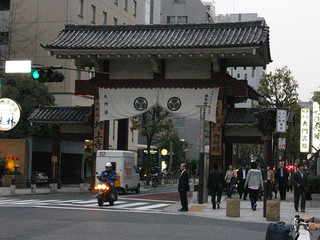- Japanese: 増上寺 (zoujou-ji)
Zôjô-ji is a Jôdo-shû Buddhist temple located in the Shiba neighborhood of Tokyo; along with Kan'ei-ji, it was one of two Tokugawa clan family temples in the Tokugawa shogunal capital of Edo. Six Tokugawa shoguns are buried on the temple grounds; the graves of five more can be found at Kan'ei-ji.
Zôjô-ji was made a family mortuary temple of the Tokugawa clan in 1598. Tokugawa Ieyasu, already planning out his (future) capital, thought the location ideal for a variety of reasons, including an association of Zôjô-ji with the south, providing a certain symmetry to Nikkô in the north. An additional worship hall was completed in 1605, and the entire complex was renovated or refurbished in 1634.
The shogunal graves at Zôjô-ji were relocated somewhat, within the grounds, in 1958; in the process, much was learned about shogunal funerary practices. Though the graves were off-limits to the public for many years, beginning in 2008, the shogunal cemetery has been opened to the public on set days of the year.
References
- Anne Walthall, "Hiding the shoguns: Secrecy and the nature of political authority in Tokugawa Japan," in Bernard Scheid and Mark Teeuwen (eds.) The Culture of Secrecy in Japanese Religion, Routledge (2006), 331-356.

